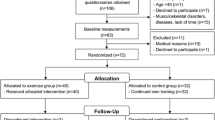Abstract.
In an ongoing prospective study of 14 recreational athletes (12 males and 2 females, mean age 44.2 ± 7.1 years) with unilateral chronic Achilles tendinosis, we investigated the effect of treatment with heavy-loaded eccentric calf-muscle training. Pain during activity (recorded on a VAS scale) and isokinetic concentric and eccentric calf-muscle strength (peak torque at 90°/second and 225°/second) on the injured and noninjured side were evaluated. In this group of patients, we examined areal bone mineral density (BMD) of the calcaneus after 9 months (range 6–14 months) of training. BMD of the injured side (subjected to heavy-loaded eccentric training) was compared with BMD of the noninjured side. Before onset of heavy-loaded eccentric training, all patients had Achilles tendon pain which prohibited running activity, and significantly lower concentric and eccentric plantar flexion peak torque on the injured compared with the noninjured side. The training program consisted of 12 weeks of daily, heavy-loaded, eccentric calf-muscle training; thereafter the training was continued for 2–3 days/week. The clinical results were excellent—all 14 patients were back at their preinjury level with full running activity at the 3 month follow-up. The concentric and eccentric plantar flexion peak torque had increased significantly and did not significantly differ from the noninjured side at the 3 and 9 month follow-up. There were no significant side-to-side differences in BMD of the calcaneus. There was no significant relationship between BMD of the calcaneus and calf-muscle strength. As a comparison group, we used 10 recreational athletes (5 males and 5 females) mean age 40.9 years (range 26–55 years), who were selected for surgical treatment of chronic Achilles tendinosis localized at the 2–6 cm level. Their duration of symptoms and severity of disease were the same as in the experimental group. There were no significant side-to-side differences in BMD of the calcaneus preoperatively, but 12 months postoperatively BMD of the calcaneus was 16.4% lower at the injured side compared with the noninjured side. Heavy-loaded eccentric calf-muscle training resulted in a fast recovery in all patients, equaled the side-to-side differences in muscle strength, and was not associated with side-to-side differences in BMD of the calcaneus. In this group of middle-aged recreational athletes, BMD of the calcaneus was not related to calf-muscle strength.
Similar content being viewed by others
Author information
Authors and Affiliations
Additional information
Received: 14 May 1997 / Accepted: 22 September 1998
Rights and permissions
About this article
Cite this article
Alfredson, H., Nordström, P., Pietilä, T. et al. Bone Mass in the Calcaneus after Heavy Loaded Eccentric Calf-Muscle Training in Recreational Athletes with Chronic Achilles Tendinosis. Calcif Tissue Int 64, 450–455 (1999). https://doi.org/10.1007/PL00005827
Issue Date:
DOI: https://doi.org/10.1007/PL00005827




